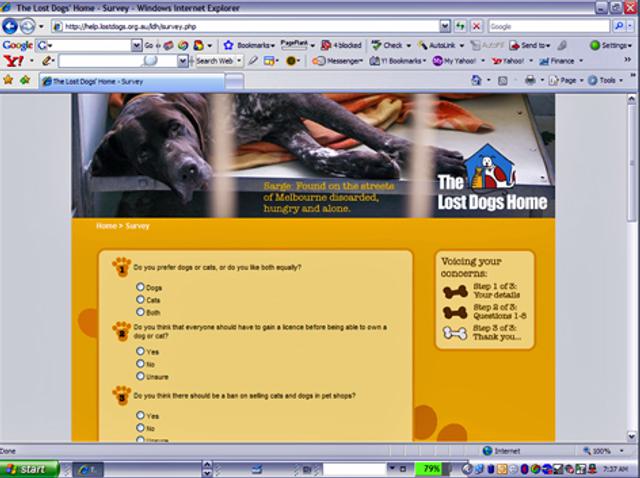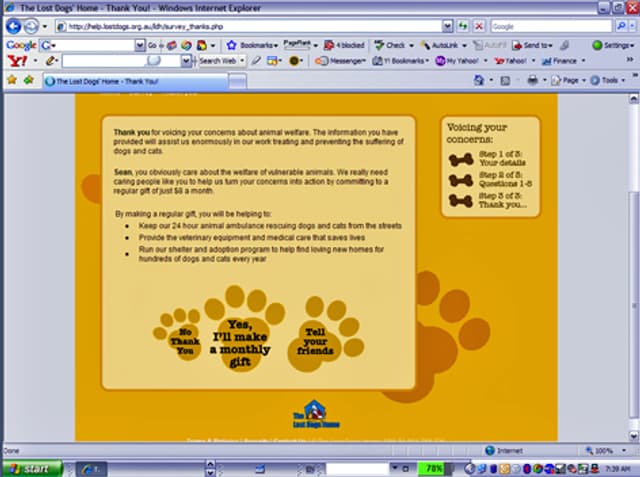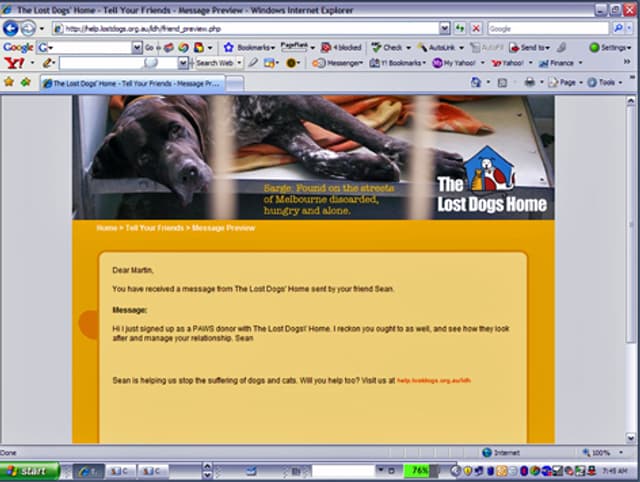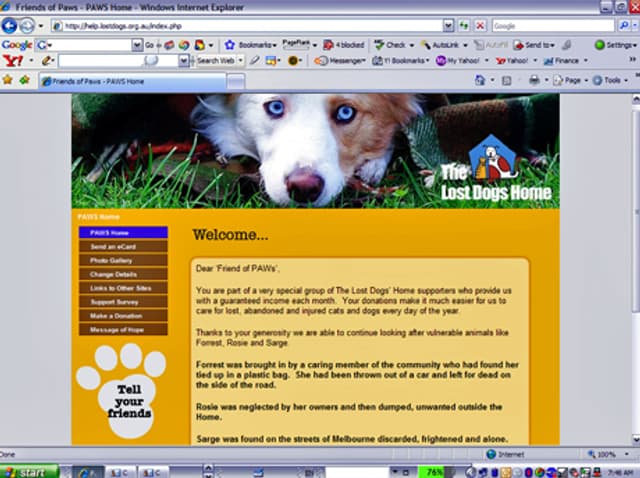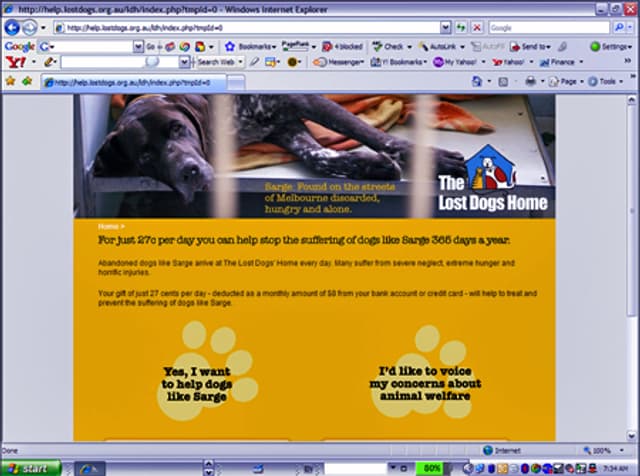The Lost Dogs’ Home, Melbourne: Friend of PAWs microsite
- Exhibited by
- SOFII
- Added
- June 12, 2009
- Medium of Communication
- Online
- Target Audience
- Individuals, regular gift, single gift
- Type of Charity
- Environmental / animals
- Country of Origin
- Australia
- Date of first appearance
- June, 2005
SOFII’s view
Although in recent years the Internet has by any definition come into its own as an indispensable tool for fundraisers particularly for fast dissemination of information and for collecting funds online in times of disaster, most fundraisers are still not adept at using the medium to acquire new donors. So the Lost Dogs’ Home’s successful experience of online acquisition should be closely watched by many.
Creator / originator
Account Director (Pareto Fundraising) – Vanessa Byrne,
Account Manager (Pareto Fundraising) – Tasman Matthews and Olivia Richards
Summary / objectives
Specific measurable objectives:
- Recruit 518 regular givers online, giving $5,754 per month.
- Generate a year one ROI of 0.49 and year five ROI of 2.37.
Additional objectives:
- Identify confirmed bequests and bequest prospects.
- Build a permission-based email list.
- Diversify the Home’s acquisition by succeeding at donor recruitment online.
- Create a truly donor-centred experience.
- Identify well-performing online media and well-performing online banner ads that can be used in future.
Background
The Lost Dogs’ Home has had tremendous success with its direct mail acquisition programme, recruiting around 7,000 new regular donors over a three-year period.
The online media space gave the Home the opportunity to diversify its acquisition approach and, through an online survey and microsite, create an emotional, donor-centred experience driven by technology.
We ran an initial, very small scale ‘online banner ad’ campaign for the Home in September 2005 and it proved to be very successful, demonstrating that the Home could recruit direct regular givers through online display advertising – an area that few Australian charities have experience in. We decided to build on this success.
This new test campaign involved testing the existing banner advertisements against some new ones, and also test taking people from the banner ad direct to a landing page or directly to a microsite. The microsite is an extremely innovative idea that took the prospect on a truly donor-centred journey.
Special characteristics
- The microsite was designed to take prospects on a personal journey – the users controlled their journey but we were still able to ‘lead them’ where we wanted them to go.
- Through clever programming, we were able to present a ‘regular giving ask’ to the prospects first, and then only give them the option of a ‘cash/one-off ask’ if they declined regular giving.
- The survey component in the microsite captured prospects’ personal information that could be used to personalise and target future communications, e.g. their bequest status/interest level, their age, their pets and pets’ names, and their personal beliefs about topical animal welfare issues.
- The microsite also detailed case studies of animals that had been helped by the Home and explained how the donors money would be used, demonstrating the tangible benefits of becoming a supporter.
- The microsite was user-friendly and made it easy for prospects to complete the action that they were being asked to make.
Influence / impact
Through this campaign, our client was able to:
- Embrace a new media channel and succeed in the online media space.
- Create a truly personal journey and donor-centric recruitment method.
- Identify a successful online acquisition strategy (including creative and media placement) with excellent rollout potential.
Details
Three key aspect that we tested were:
- Media placement: Testing different media suppliers and also the positioning and ‘criteria’ helped us to identify what would be best to use for future roll out.
- Creative and proposition: Different creative treatments consisting of three separate case studies were tested against each other to see which would have strongest roll-out potential.
- Landing page versus microsite: The landing page consisted of an ‘all-in-one’ online form for the viewer to make a donation. The microsite was a mini-website that took viewers on a journey and gave them different things to do, from becoming a donor to filling out an online survey.
Costs
Media – $77,000
Development, design, tracking & agency fees – $75,000
Results
Results for this online campaign exceeded all projections. The most noteworthy results included:
- 664 regular givers were recruited – 28 per cent above target.
- Monthly regular giving income amounted to $7,902 – 37 per cent above target.
- Year one ROI was 0.64 – 31 per cent above target.
- Year five ROI was 3.14 – 32 per cent above target.
- The media-only ROI was 1.27 for year 1, and 6.20 for year 5. Since the outlay of design and microsite has been completed, the campaign can be rolled out with minimal investment apart from media space. These media-only ROI therefore bode extremely well.
- In addition, 789 online surveys were completed. These responders were added to the existing communications stream. The Home’s bequest officer followed up anyone who answered the question on bequests. Answers to surveys are also being used to personalise communications.
Merits
The outcome of the campaign was so impressive because it conquered new ground for The Lost Dogs’ Home, Pareto Fundraising and Australian charities in general. Very few charities in Australia are doing online acquisition so there was limited knowledge about how best to approach the campaign and what our expectations should be. The microsite we created was extremely innovative and the campaign created a unique and personal journey for prospects. Superb results for the Home exceeded their direct mail acquisition results in the test phase alone.
Other relevant information
Click here to see the site.
Also in Categories
-
- Digital fundraising



